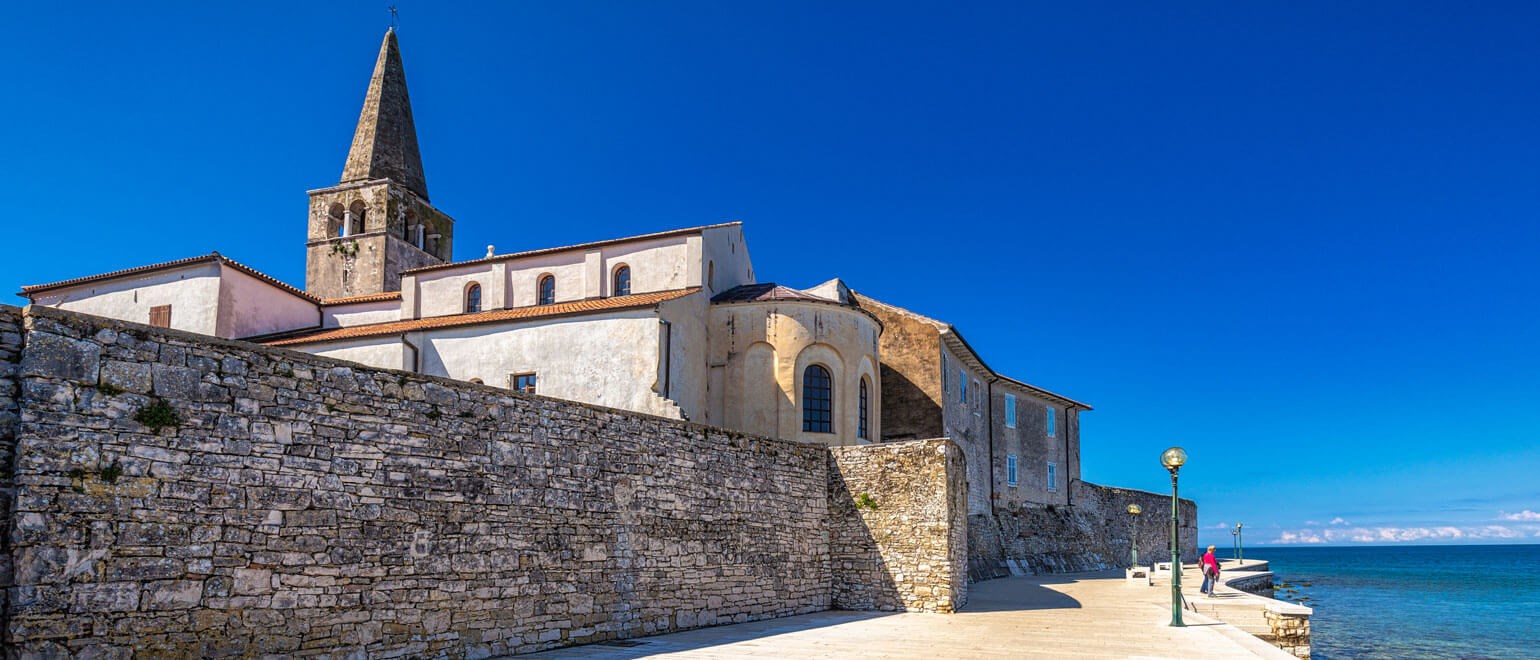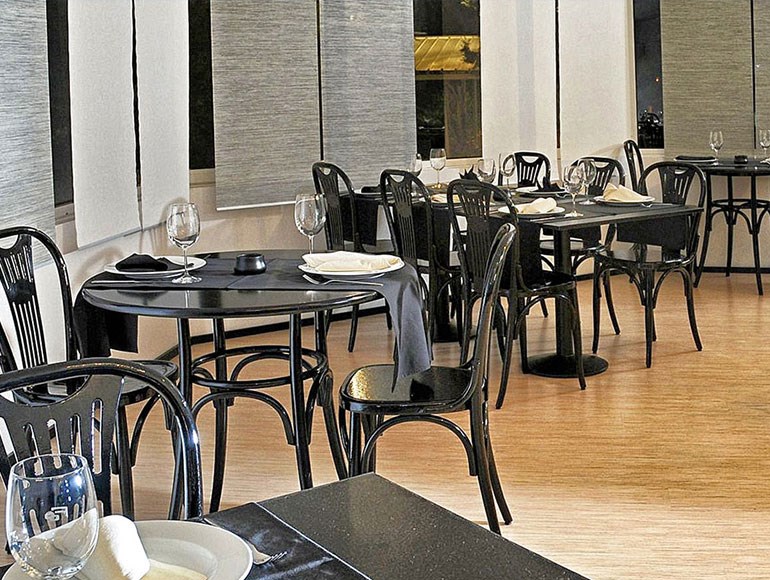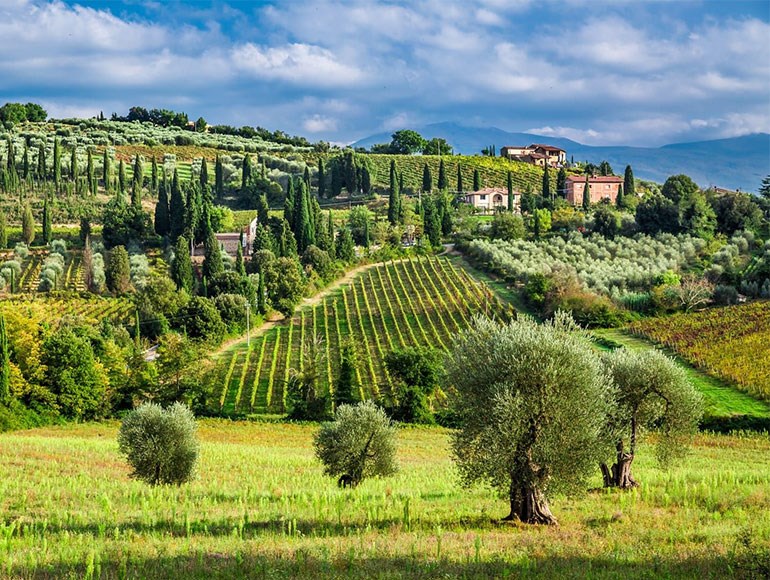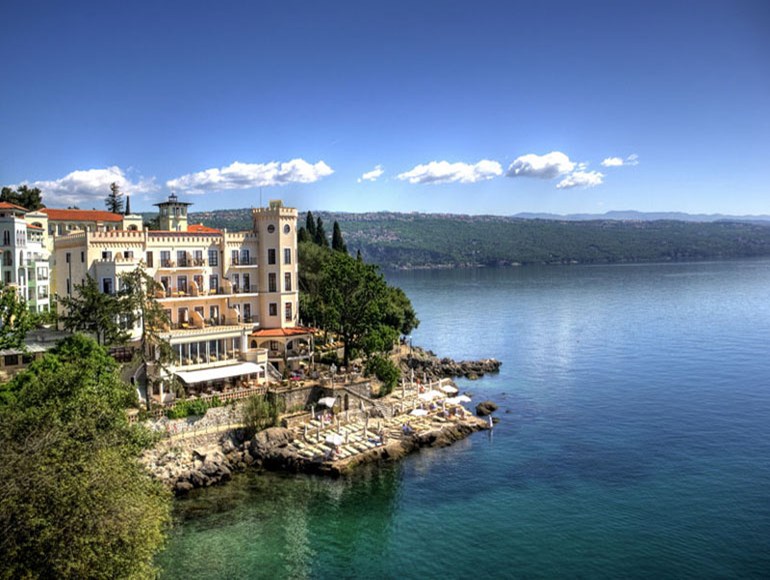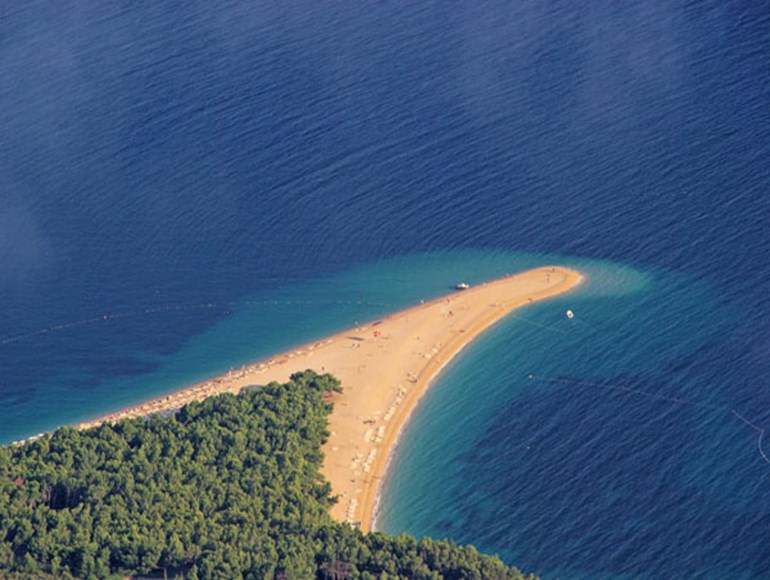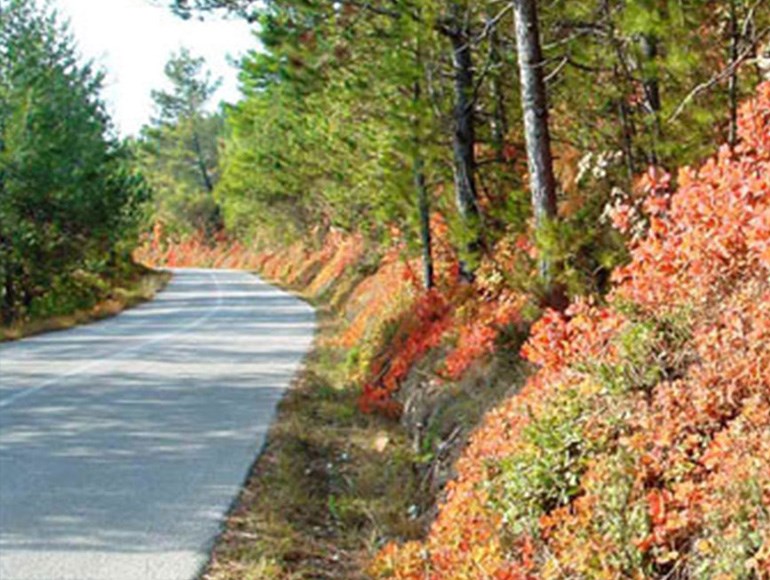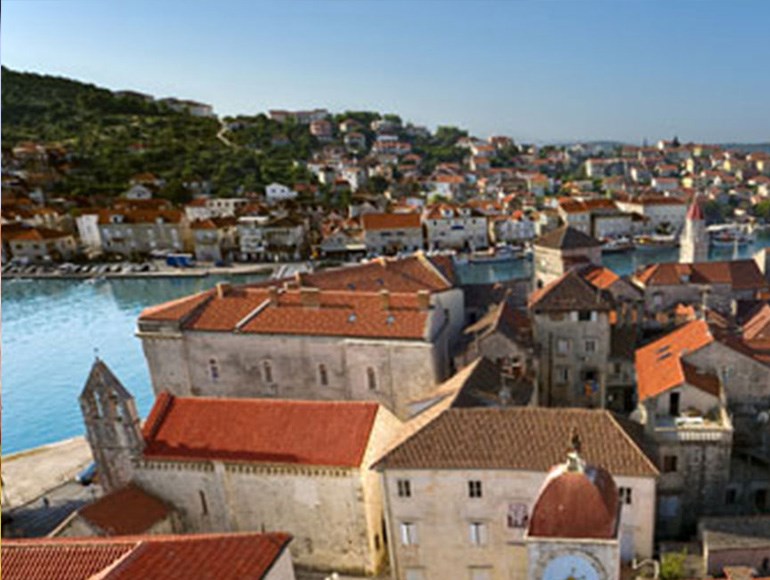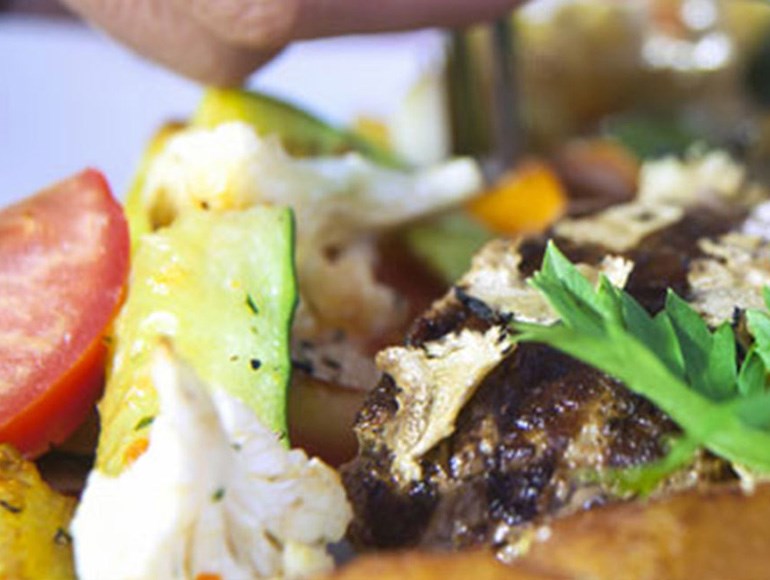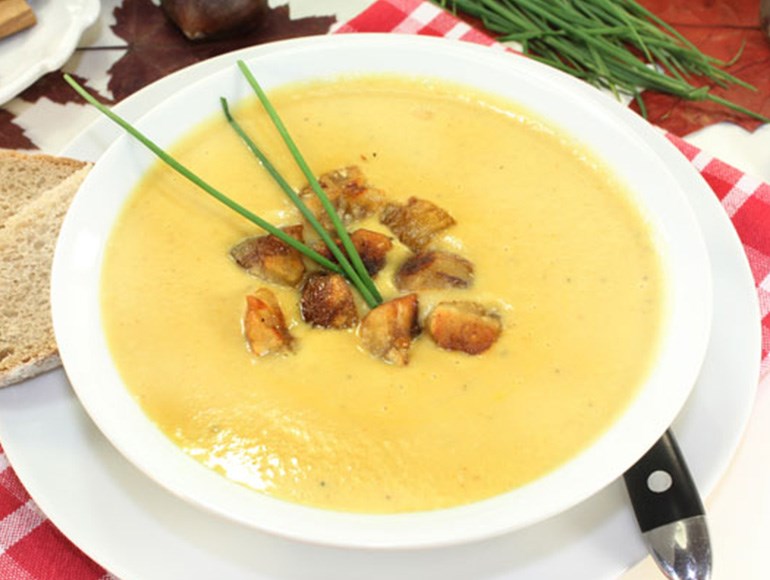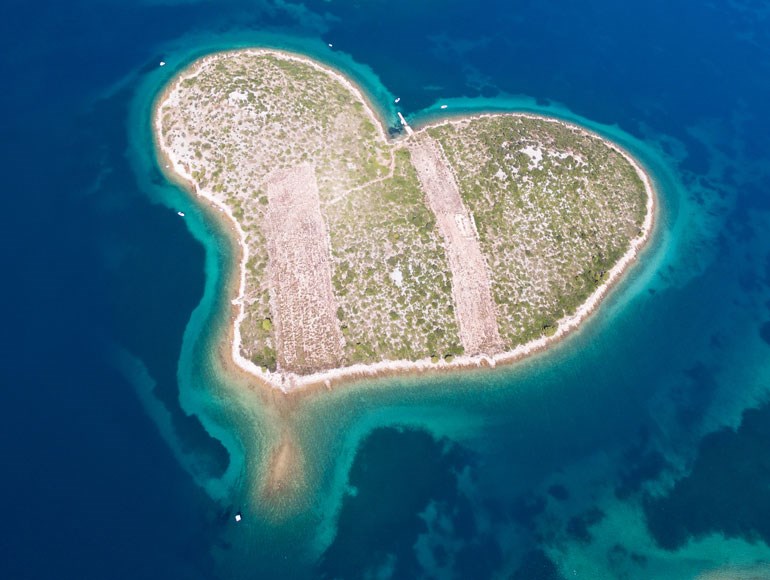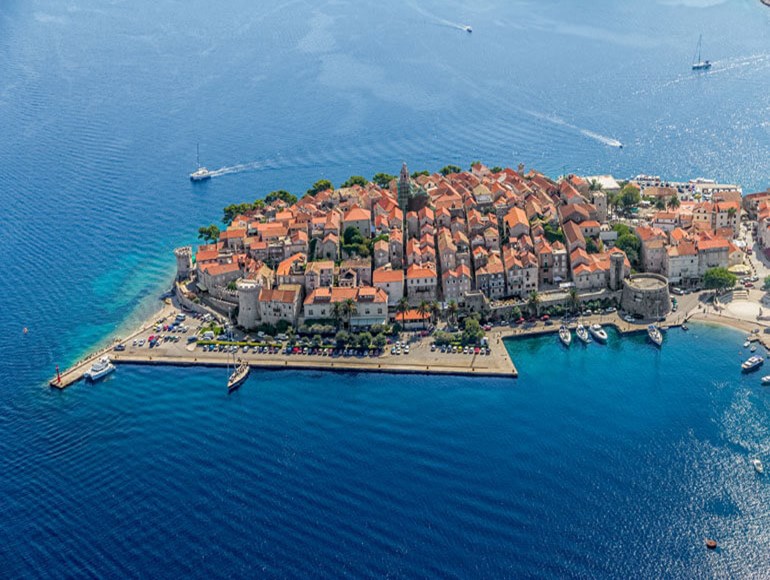I have selected ten of my favourite Istrian churches. They have been chosen for their architecture, their history, their interiors and in some cases just for their setting and the beauty of the landscape or townscape in which they stand. There are many things to do in Istria but in visiting these churches you will have a taste of much that makes Istria a wonderful holiday destination: seaside, medieval hilltop towns, vineyards, olive oil, gourmet food, Roman history, Venetian architecture and glorious landscapes.
Itinerary
To help you plan an itinerary for a driving tour I have ordered my top ten churches from North to South:- Church of St Michael, Sterna
- Church of the Blessed Virgin Mary of the Holy Rosary, Zavrsje
- Church of St Stephen, Motovun
- Church St Nicholas, Rakotule
- Church of St Simon and St Jude Thaddaeus, Tinjan
- Church of St Peter in the Forest
- Episcopal Complex of the Euphrasian Basilica, Porec
- St Euphemia, Rovinj
- Church of St Blaise, Vodnjan
- The Chapel of St Mary Formosa, Pula
St Mihaela (St Michael), Sterna
The church in the tiny village of Sterna is unusual for its simplicity and the way in which it blends into the surrounding landscape. It is not a statement of power and wealth as is the case with many churches. Quite the reverse. Were it not for its solid square tower the main church building could be mistaken for a barn or farmhouse. Built with the honey coloured local stone under a typical weathered Mediterranean tiled roof the church is a statement of modesty total aligned with the local rural architecture. The tower stands tall and proud beside the church.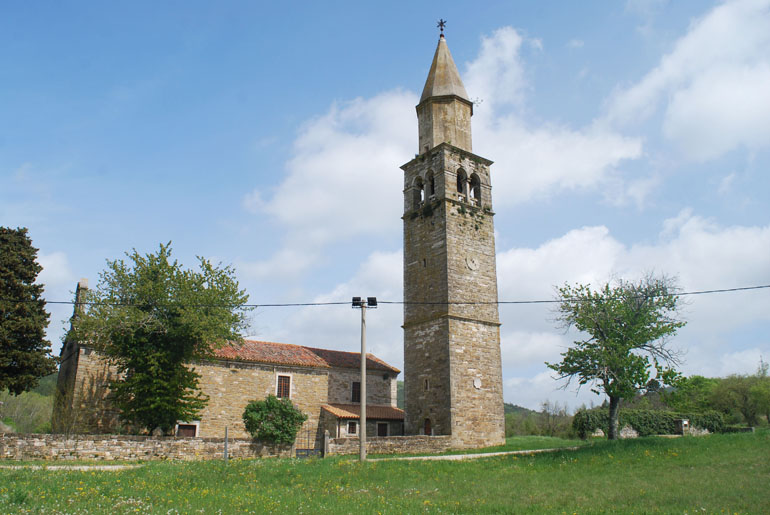
The approach to Sterna adds to the magic of this place. The village stands at the end of a wide high valley in the beautiful landscape to be found to the north of the River Mirna. The road winds its way along the valley from the west. There are no hedges or fences providing a boundary at the road side. The verge extends effortlessly in the lush green undulating meadows on either side. Approaching the village the church appears to stand almost within the fields. The churchyard is separated from the road side and fields by a low stone wall and a simple iron gate no different to that which might enclose a local cottage or farmyard. A couple of trees and a purple lilac stand beside the church.
The simple beauty of this church and the surrounding landscape excites me every time I approach it.
The village house of Casa della Vigna in Oprtalj is a good base from which to explore this area of central Istria.
Crkva Blažene Djevice Marije od Svete Krunice (Church of the Blessed Virgin Mary of the Holy Rosary), Zavrsje
The parish church in the tiny village of Zavrsje makes it into my top 10 selection not for the church architecture or for the wealth and decoration of its interior but simply for its setting. Zavrsje is a tiny medieval settlement hidden away in the hills that overlook the Mirna valley in North Istria. It is difficult enough to find even when you know where it is and that makes the arrival all the more memorable. Approaching from the north by a road that winds gently downhill through woodlands you emerge from the trees to find this village perched on a rocky outcrop that juts upward from the surrounding landscape.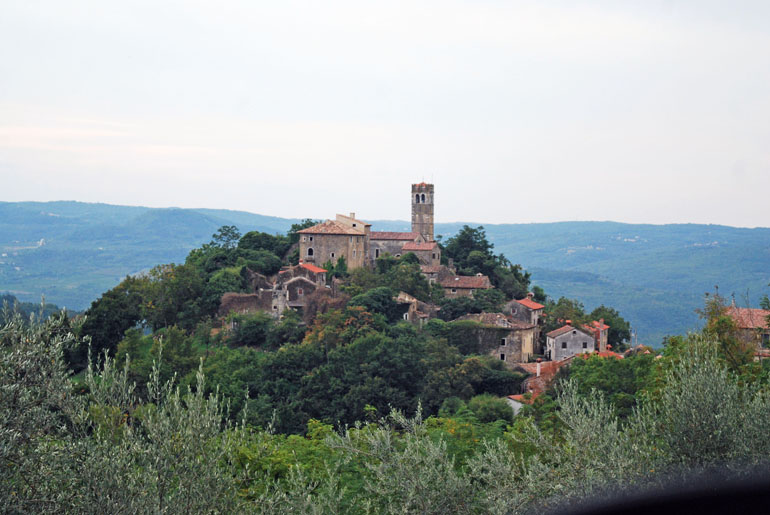
The village houses climb up the steep hillside which is topped by the square stone Romanesque bell tower of the Church of the Blessed Virgin Mary of the Holy Rosary. The church itself is of the late Gothic period but altered in the 17th century. Walking up the steep pathway towards the church you will discover that the further you penetrate into the centre of the village the more derelict and yet the more evocative of its ancient past that it becomes. Passing the church and emerging through to the far side of the village a broad panorama over the Mirna valley opens up. Capturing these views are a handful of renovated houses.
Parish Church of Sveti Stjepan (St Stephen), Motovun
The parish church of St. Stephen in located on the main square in the hilltop town of Motovun. Beside the church stands an impressive 27 metre high 13th century bell tower built originally as a defensive tower and observation post. The church was built around 1600 on the site of an earlier basilica and later remodelled in the Baroque style that is seen today.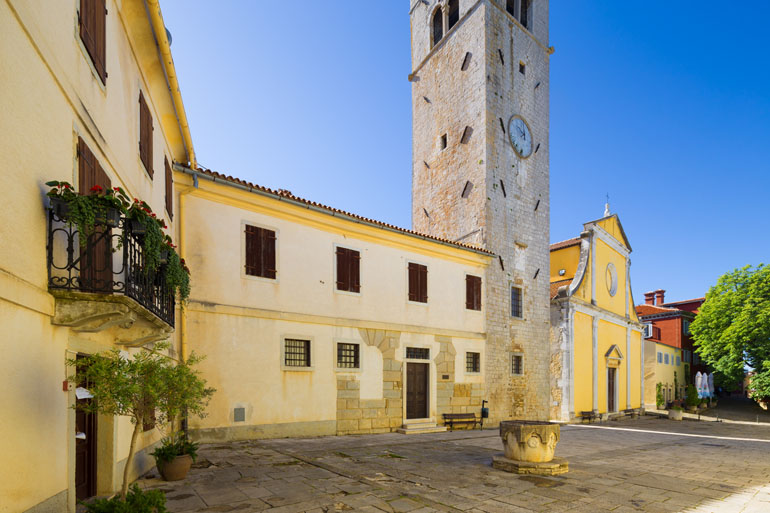
The town of Motovun stands on a conical hill that rises steeply from the valley of the river Mirna. It was fortified in the 14th century and much of the fortifications remain today. A walk around the ancient walls followed by a coffee in the town square to take in the view of the church and the surrounding municipal buildings which include the Romanesque Praetorian Palace is the best way to absorb and appreciate the medieval atmosphere of this breathtaking hilltop town.
In July or August every year the town square becomes the venue for the open air film screenings of the internationally recognized Motovun Film Festival.
The most memorable views of Motovun are looking back to the town from the surrounding hills with early morning mists still trapped in the valleys and town's tower and walls breaking free into the clear sky above.
Our Villa Merlot offers one of the best vantage points to enjoy these ever changing views.
The Church of Sveti Nicole (St. Nicholas), Rakotule
A few miles south of Motovun deep in the Istrian countryside you will find, with a bit or searching and a few wrong turnings, the tiny church of St. Nicholas in the cemetery that serves the village of Rakotule. The church building is Romanesque, very simple and dates from the 14th century. As you approach the church the woodland opens up to reveal views across the valley to the iconic hilltop town of Motovun.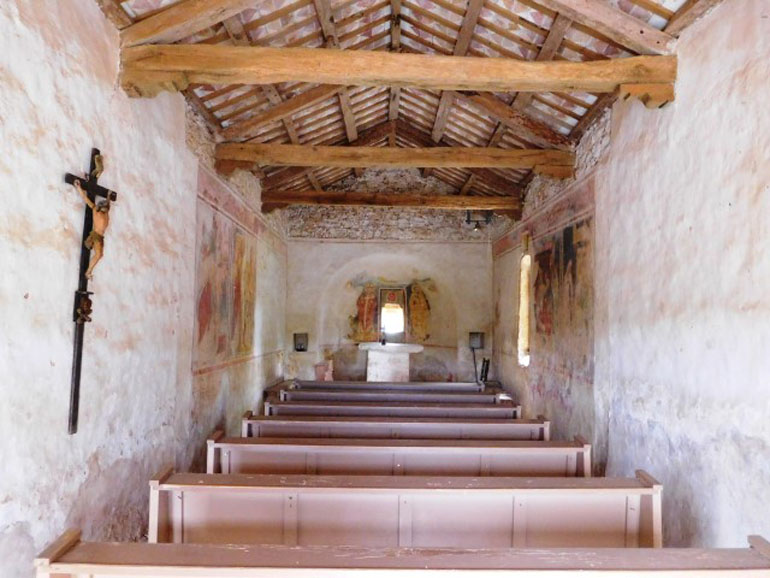
The simple beauty of this ancient church and the glorious views across the Mirna valley are only part of the treat that awaits you. Inside this church are probably the finest and best preserved frescos in Istria. The work of Italian artists, these frescos would have been commissioned at considerable cost and it is remarkable that such an investment was made for a tiny church that can seat barely a couple of dozen people. But the intimacy of the interior reinforces the impact of the scenes depicted.
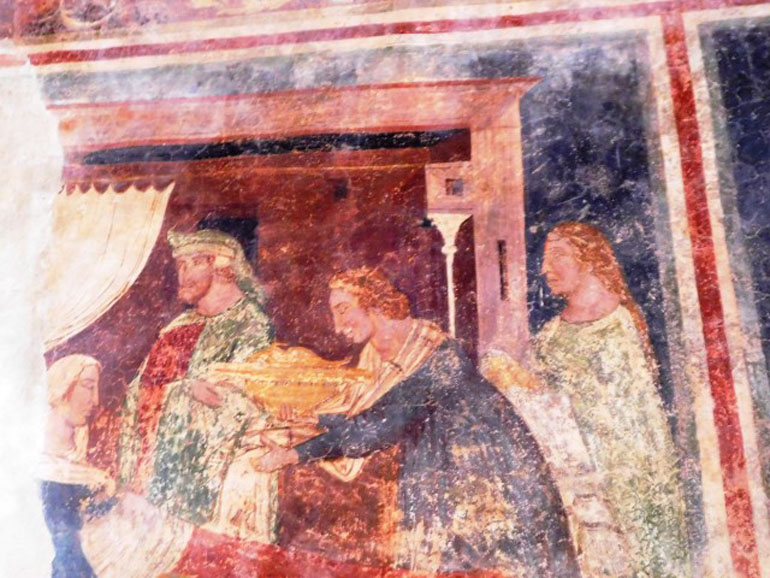
The frescos were discovered in 1925 by the local priest Luka Kirac. Kirac was a historian and proud defender of the Slavic heritage of the Istrian people. He opposed Italian irredentism, the nationalist movement which promoted the unification with Italy of those areas in which a substantial proportion of the population were Italian speaking or ethnically Italian. His opinions and writings brought him into conflict with the Italian authorities (who controlled Istria after the end of the First World War in accordance with the terms of the 1915 Treaty of London) and he was in effect exiled to remote parishes. This brought him to the parish of Rakotule in 1925 and where in 1928 he completed the writing of an important work of Istrian history which was ultimately published in 1946 when Istria was liberated from Italian control and became part of Yugoslavia.
Images of St Nicolas Racotule reproduced by kind permission of Jan Sonnermans
Church of Sv. Šimuna i Jude Tadeja (St Simon and St Jude Thaddaeus), Tinjan
Tinjan is a pretty town standing in an elevated position at the head of a deep valley providing stunning views from vantage points at the entrance to the town. Entering the town you are drawn into narrow alleyways and turning a corner you will confront the Baroque façade of the parish church of St. Simon and St Jude Thaddaeus.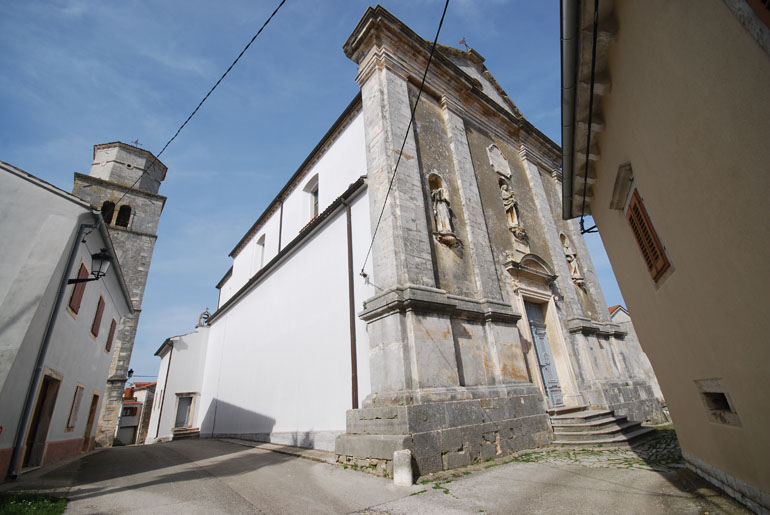
It was built in 1773 with a mix of neoclassical and baroque elements.
Whilst in Tinjan visit the Depiera Collection, a small museum housing a collection of thousands of objects associated with life and work in Tinjan and the region over the centuries.
Tinjan is famed for the quality of the local Pršut (prosciutto or smoked ham) produced in the region so if your visit coincides the annual prosciutto festival in October take the opportunity to sample a few slices.
Church of Sveti Petar u sumi (St Peter in the Forest), Sveti Petar u sumi
This magnificent group of ecclesiastical buildings is striking for its scale which dwarfs everything around it and most other churches in Istria. Originally the site of a Benedictine monastery dating from the 10th or 11th century the church of Sveti Petar u Sumu (St Peter in the Forest) was changed and adapted over the years notably following a fire in 1755 which was when the baroque facade which can be seen today was added.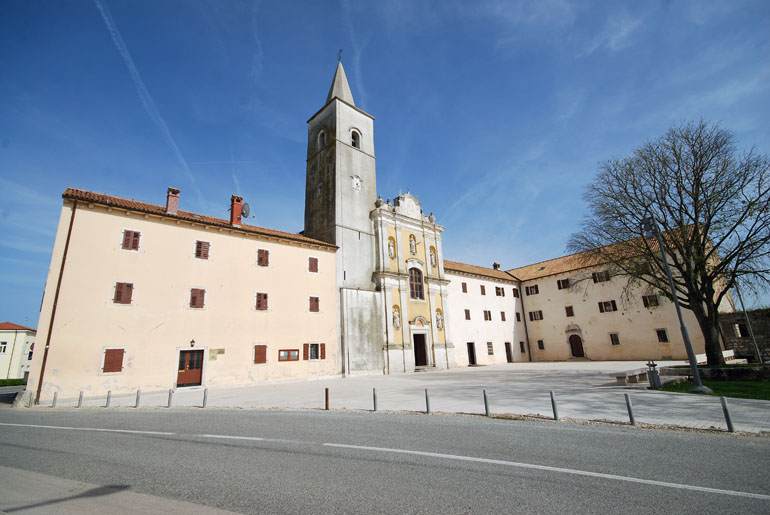
The monastery passed from the Benedictines to the Paulines (the white monks) in 1459 and the Pauline order is still involved today. The interior is notable for the image of Our Lady of Czestochwa, above the main altar in the church, and the adjoining cloisters.
The village of Sveti Petar u Sumi has nothing particular to recommend it and the location does not have the scenery and views that are typical of the hilltop towns. But the church itself is a must see. Its massive presence cannot fail to impress.
Episcopal Complex of the Euphrasian Basilica, Porec
Porec is a popular and busy tourist resort and if you confine your stay to the modern hotel complexes you would never imagine that Porec had been an important administrative centre for the Roman Empire in the second century AD. After the Roman Empire split Porec came under the influence of the Eastern Empire introducing the Byzantine architecture that created one of the most important religious buildings in Croatia, the Episcopal Complex of the Euphrasian Basilica also known as the Cathedral Basilica of the Assumption of St Mary.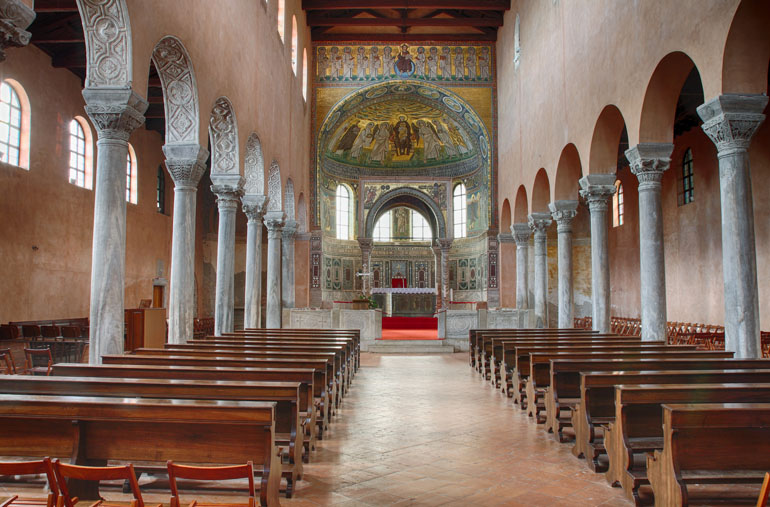
This group of religious building was designated with UNESCO World Heritage status in 1979 with the following justification:
"The group of religious monuments in Porec, where Christianity was established as early as the 4th century, constitutes the most complete surviving complex of its type. The basilica, atrium, baptistery and episcopal palace are outstanding examples of religious architecture, while the basilica itself combines classical and Byzantine elements in an exceptional manner."
An important feature of this complex of building are the mosaics; both floor and wall decorations.The Basilica was constructed between 550 and 560 AD and the wall mosaics were laid by Byzantine masters. The building was on the site of an earlier basilica and the 5th century floor mosaics from this earlier building have also been preserved.
St Euphemia, Rovinj
Rovinj is the perfect picture post card town and much photographed. A small conical peninsula attached by a narrow strip to the mainland is packed full of quaint and colourful Mediterranean houses which climb directly out of the water and rise steeply to the peak of the peninsula on which stands the church of St Euphemia. Already standing high above the rest of the town the 61 metre high bell tower makes this church the ever present focal point from whatever angle viewed. The church is reached by walking up the steep winding alleyways between the tightly packed houses which today serve as restaurants, bars, boutiques and art galleries.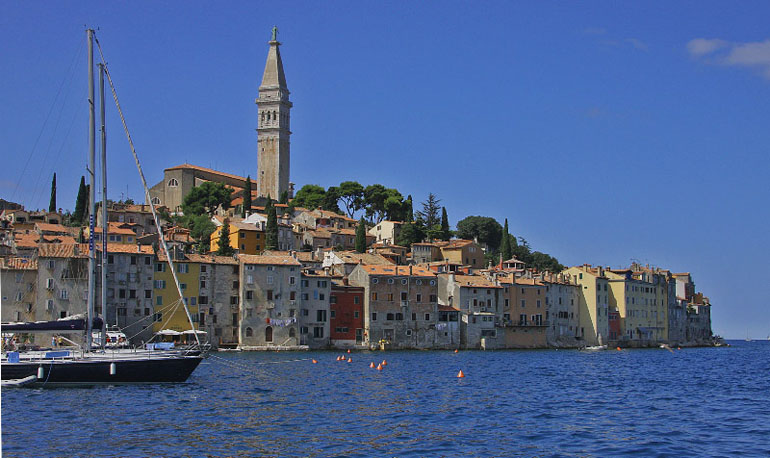
Once at the top the terrace and gardens around the church are shaded by pine trees and offer a wonderful panorama across the Adriatic towards Italy and up and down the Croatian coast.
The church was built in the Baroque style between 1725-36, on the site of an earlier Christian church and the façade dates from 1883. The bell tower is earlier, built between 1654–1680, and modelled on the tower of St Mark' Basilica in Venice. A statue of Saint Euphemia stands at the top of the spire.
Inside the church are the remains of St Euphemia and works of art including 15th century statues and paintings from the 16th to 18th centuries. Among these is a picture of the martyrdom of St. Euphemia.
Parish church of Sveti Blaz (St Blaise), Vodnjan
The 62 metre high bell tower of Vodnjan's parish chursh of Sveti Blaz (St Blaise) - the highest bell tower in Istria - is a veritable landmark visible for many miles around. At night its illumination makes it even more prominent. The church was built between 1761 and 1800 to replace an earlier 11th century Romanesque basilica that had become too damaged to repair. The new church was built in Baroque style. Its front façade is adorned with five life size statues of saints on its roof line.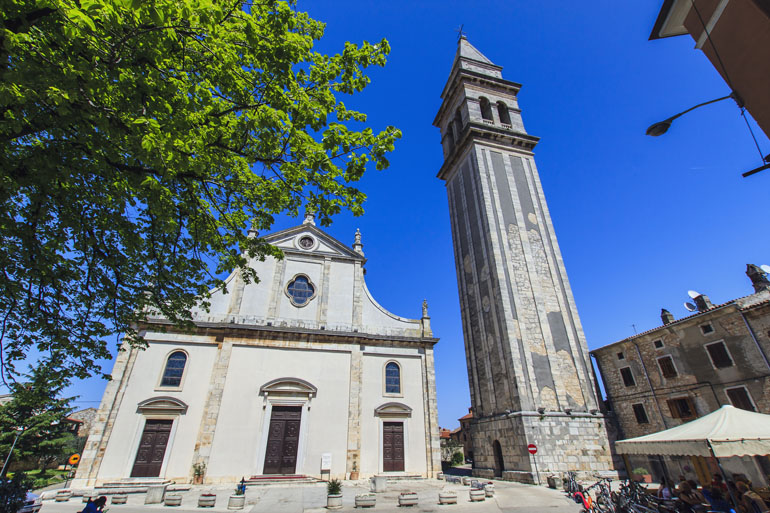
The interior is well worth inspection and is notable for its nine magnificent marble altars. Within the Catholic faith the church is also known for its collection of mummified bodies of saints.
The bell tower which stands separately from the church was added in 1881/2 and is modelled on the tower of San Pietro di Castello in Venice.
Vodnjan itself has an attractive 500 metre long main street lined with medieval buildings that leads down to the main town square from where it is a short walk to the church of St Blaise.
The Chapel of St Mary Formosa, Pula
Pula is famous for its remarkably well preserved Roman amphitheatre dating from the 2nd century AD but it has other important Roman and early Christian structures. The Chapel of St Mary Formosa is the surviving part of what was once a magnificent 6th century three- nave basilica commissioned by Archbishop Maximianus of Ravenna. What we see today is only the south chapel. The original building was much damaged during the Venetian attack and fire in 1243.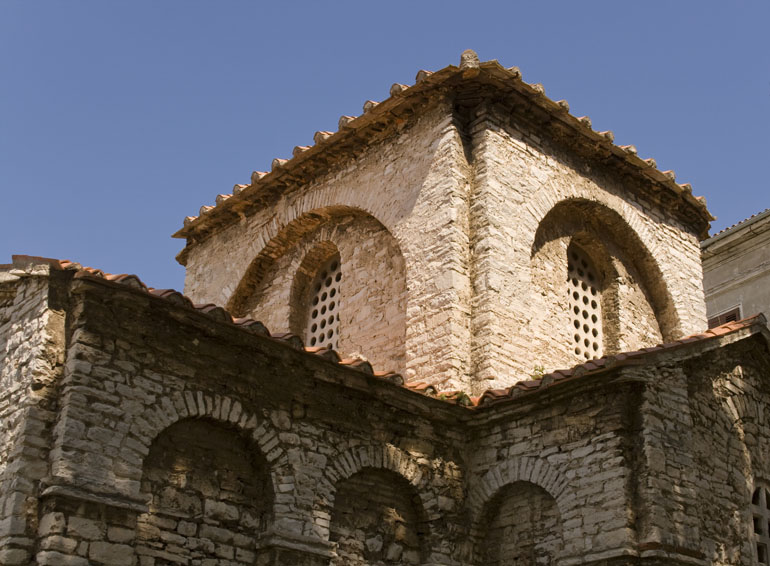
The north chapel was later absorbed into nearby residential buildings and the main part of the Basilica had fallen into ruin by the 16th century. Some of the original mosaics are preserved in Pula's Archaeological Museum.
The south chapel remains well preserved and is an important early Christian monument. The surrounding area does no justice to the importance of this building which stands rather neglected in open land between the shipyard and the main pedestrian shopping street. But there are plans to create a museum beside the chapel and to do proper justice to this fine example of an early Christian church.
Where to stay
The motorway that runs north south down the length of the Istrian peninsula makes most places accessible within about a one hour travel time. So even if you wish to tour around you can base your self in one location.Browse our villas in Istria to find one that suits your needs or give us a call to discuss.


